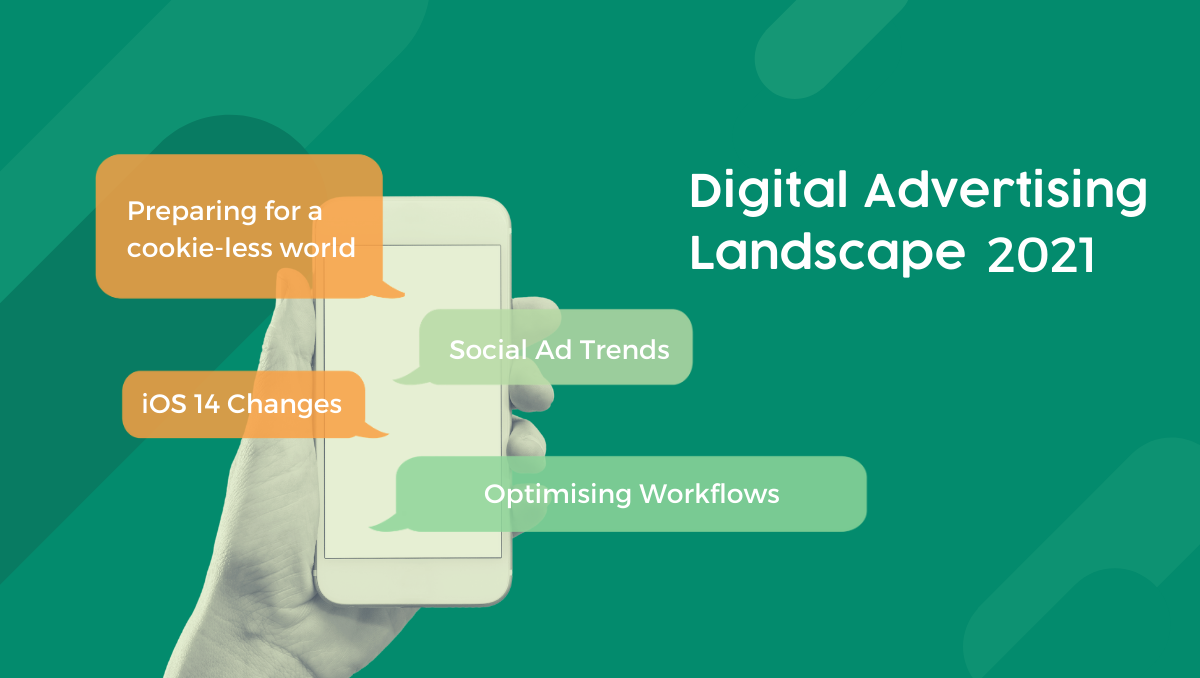The digital marketing landscape is about to shift dramatically.
The evolution of fan data in the last 10 years has been extraordinary. With this, the amount of information that we - as marketers - have been able to access about our fans has been growing year by year. However, beginning with the iOS 14 release changes, we see a dynamic shift in data privacy on the horizon.
Fear not, the Tradable Bits Advertising team has come together to put minds at ease. The team recently hosted a webinar to share their insights about the Advertising Landscape of 2021, which you can watch here.
Read on for a high-level overview of what the iOS14 changes mean for Facebook advertising, for strategies to retain a deep understanding of fans in an increasingly cookie-less world, for social ad trends, and for our top tips on how to do more with less in 2021.
1.iOS14 - The Elephant in the Room
What is it?
OS 14 is one of Apple’s biggest operating system updates to date. With it comes some new tracking/measurement tools, including what is called “Private Click Management (PCM)”. Essentially this means that users will be asked to opt in to allow apps to track them for a personalized experience.
There are still many questions about how iOS14 will specifically impact the digital ads landscape, however, the following are overarching changes all digital marketers should be aware of:
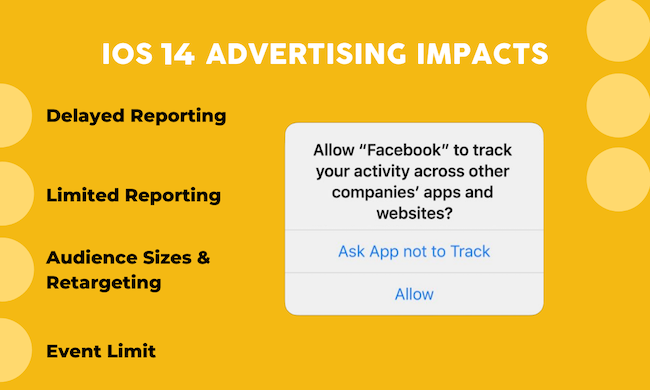
1. Delayed Reporting (24-48 hours)
We’ve become accustomed to real-time reporting. Unfortunately, we’ll have to adapt to a slower information environment with delayed reporting. This is because Facebook will not have access to data from Apple as quickly as they used to. Therefore, if your strategy relied on short-burst campaigns and optimizing based on data collected by pixels, you may want to think about increasing your timeline. The delayed reporting is even worse for apps, with a delay in up to 72 hours.
2. Limited Reporting:
When it comes to reporting, two major changes are on the horizon: Reduced attribution windows and reduced demographic breakdowns.
i. Reduced Attribution Windows:
Traditionally, we have operated on a 28 day click and 1-day view - meaning that if any fan clicks on your ad and completes a conversion over a 28 day period, we can attribute that view/click, and will see that as a completed purchase.
On the horizon is the move towards a 7-day click and a 1-day view. Because we will not be able to attribute clicks over as long of a period - we’ll have to get used to seeing far less conversion.
ii. Reduced Demographic Breakdowns:
While marketers will still be able to see demographic breakdowns based on the people that visit their site, all event tracking data (including things like conversions, ‘add to carts’, etc) is going to be aggregated. This means that we will no longer have the ability to see demographic breakdowns from this data.
3. Reduced Audience Sizes & Retargeting Efforts:
The impact of the first two changes and the emphasis for fans to opt-out of tracking will lead to smaller audiences. We will also see far more overlap between audiences when we start to segment it. And for marketers, this is quite a blow. However, as the saying goes,
“out of adversity comes opportunity.” In a world where less data is available, having ownership over your own networks and first-party data will become a competitive advantage.
4. 8-Event Limit:
If the user opts into tracking, we’ll be able to track & optimize for 8-events (for the ad-set level), which could include things like content view, completed purchase, website visit, etc. If the user opts out of tracking, this becomes limited to 1 event, which is chosen based on the priority you set for each event. This means that your 8-event prioritization needs to be done right. Along with limitations, a new feature called ‘value optimization’ will come with these 8 events. This feature will use the information gleaned from the 8 events to allow the pixel to learn, to find, and target people who are going to convert higher.
For most of our partners, lower-funnel events tend to be the most important data they collect, especially when they’re tracking ROAS. Therefore, we recommend prioritizing purchasing/conversion information, so that you are able to track this as your one-event, even if the user opts out of tracking.
2. The Way Forward - First Party Data
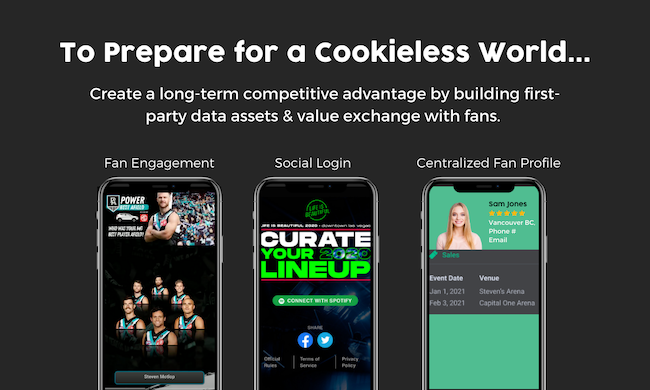
First-party data is information you collect directly from your fans or audience. This information can include behaviour, actions, or interests demonstrated across websites & apps, subscription and purchasing data, social data collected across fan networks, and the historical data that has been built up in CRMs. First-Party data allows you to get a full-picture idea of who your fan is beyond traditional demographic data.
In 2021, the collection of first-party data & investment in technology around privacy changes is a top priority for businesses. In a world where consumer distrust is high, and legislation is pushing for a reduction in third-party data, building first-party data assets through true value exchange with customers, will create a long-term competitive advantage.
So how do you collect first-party data?
Fan Engagement: We don’t live in a one-way world of communication, and fans expect value from brands in exchange for information. At Tradable Bits, we see our partners excelling in their relationships with fans by building authentic, curated campaigns that they know their fans will love. Fans acknowledge the effort and appreciate it. As a result, they’re more likely to share details about themselves that the brand can use to curate their relationship further.
Social Login: This also relies on campaigns that offer fans enough value to participate in. However, instead of custom questions and emails to fill out - the fan can choose to authenticate through another network - including Instagram, Spotify, Facebook, Discord, etc - uncovering information from these networks.
Sales Integration: Purchasing history is key when speaking to fans. To know whether they’re first time-buyers or loyal fans will set the stage for your communication funnel.
Wifi Authorization: At live-events, this is your ticket to collecting more information about your fans from other networks.
Finding new ways to collect first-party data is key. Then comes the need for data integration and centralization.
To bring about the best performance we can with the data we have, we need to funnel our information into a centralized ecosystem. We can’t understand our fans if the puzzle pieces to their identities lie siloed in different networks. When we put all of our data together in one place, we start to see that data transform into a story about our fan. And this is how we go beyond demographics to speak to our fans in a way that maximizes value exchange.
Finding look-alikes of ticket buyers, and thorough affinity analysis will be high priority issues in 2021 - especially as the digital marketing landscape moves back towards privacy prioritizations. To do this effectively in a less-transparent data environment, we recommend starting with the fan. At Tradable Bits, our philosophy has always been “be fan-centric.” Long-term success begins by building a strong seed audience, that you can then build out from. Start with fans you know will convert, and expand your horizons outwards, instead of using the traditional marketing funnel which starts with high-spend for prospecting.
3. Digital Ad Trends in 2021 - What Rapid Growth in 2020 Means for Tomorrow
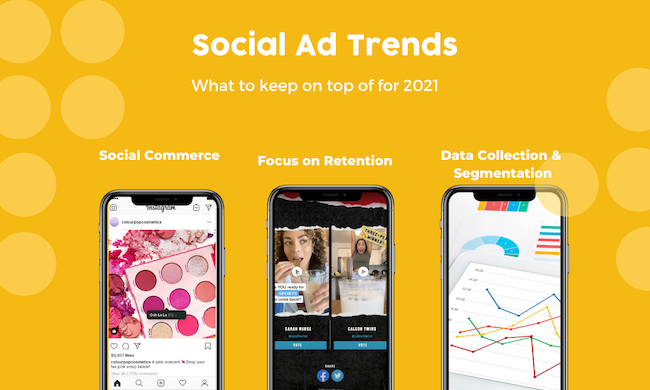
We’ve all become accustomed to the giant ‘P’ for pandemic. For many of us, 2020 was a year of pushing our identities online, finding comfort in our favorite TikToks, ‘window’ shopping on Instagram, with the younger generation taking back to Snapchat to stay in touch with friends.
We’ve truly adopted a ‘digital-first’ mindset. It’s no surprise then, that we’ve seen a 10.5% annual increase in the total number of social media users - or 376 million users. For digital marketers, while this increase in audience means more people to reach, it also means increased competition as more brands narrow in-on socials. A combination of external pressures and new consumer behaviours have led the Advertising team at Tradable Bits to narrow down on the following trend to define social media in 2021:
1. Social Commerce - It's Time to Optimize
Ecommerce has exploded, and we can safely assume that social commerce is going to be the next organic state of evolution. Put simply, social commerce is the act of buying products directly through your social media app. From the new Facebook and Instagram storefronts to the partnership between TikTok and Shopify, social commerce is the new ‘it-girl’.
The days of customers seeking out a product is falling further from the truth. Because fans no longer expect to look around for products, it’s important that your digital touchpoints make your offerings clear, and allow fans a seamless purchase experience. Digital commerce should most certainly be a part of your roadmap in 2021.
2. A Focus on Retention - Spoil your Fanbase
As said above, we’ve seen a huge increase in social media usage this last year. This increased activity has welcomed increased competition, with more advertisers looking to social media to grow their audience. Unsurprisingly this has resulted in rising acquisition costs. And the excess budget to deal with rising cost-per-clicks and CPM’s is in short demand this year. Therefore, retention of existing fans is key.
3. Data Collection and Segmentation - Start with First-Party Data
Not to sound too repetitive, but there are barriers coming to data collection & segmentation. With things like private-click management, limited reporting, audience overlap, and the push to a cookie-less future on the horizon, brands are going to have to take targeting into their own hands. We recommend building up your customer database with first-party data today. That way, when the ball does drop, you’ll be prepared to offer those same personalized experiences that lead to higher ROI, CTR, and reduced CPC.
4. An Omnichannel Approach - A Venn Diagram straight to your Fans' Hearts
As said by Margo Hayes, “Where is your customer - and where are they inspired - and then you deliver the message there.” Focusing on only one network may mean that you’re missing out on high-impact incremental reach on fans. But at the same time, we know that your communication needs to be curated to the specific culture of each network. In 2021, we see omnichannel investment as key. Understand where your fans are, then reach them on those networks. For us, this means prioritizing long-term growth over short-term ROI - so you don’t miss out on that next group of fans.
4. Automated Media Buying - Offloading Work in 2021
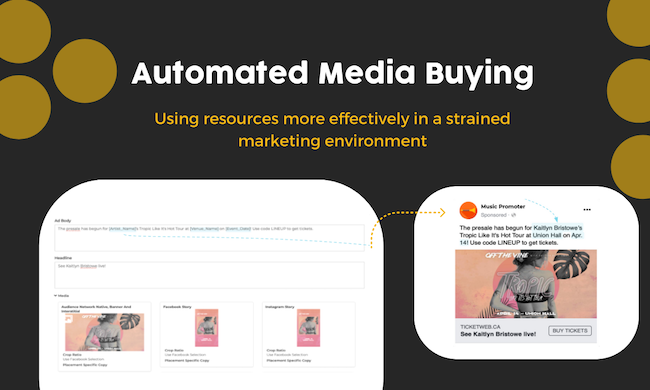
2021 is going to be a whirlwind of a year for everyone from the looks of things. We will definitely see the return of live events, but the exact date is still a mystery depending on the region. A lot of organizations are still dealing with limited resources. Organizations will be forced to make difficult decisions about the tools they use, the resources they have, and their overall strategy for an uncertain environment. When it comes to optimizing resources and time - automation is the way forward.
Why Automate?
Many people are facing the same issues. They are expecting to have a large volume of campaigns, to run with little time and few resources. The best solution, in many cases, is to automate. This involves things like creating intelligent audiences, template-driven ads, and centralized reporting that reduces the number of resources needed.
When you offload processes that are a huge time sink on your team, you open up space for people to breathe, think and strategize. In the long-run, this ability for your team to thrive will result in better outcomes for your entire organization.
Key Takeaways
The digital marketing landscape is shifting: it’s will be important to stay on top of the changes coming down the pipeline
First-Party Data is becoming a key business priority as legislation & consumer sentiment push us away from 3rd party data sharing
Social Trends this year focus on retention, commerce, and an omnichannel approach
It’s time to offload strain and automate - so you can work most effectively with the resources at hand in 2021
We know that’s a lot to take in, but the changes that are being introduced to the landscape by the iOS 14 launch cannot be overstated. Our Ads team at Tradable Bits is here to help you overcome these changes and to strategize your fan marketing initiatives for 2021. Contact us here to get started on building your fan-marketing ecosystem today. If you’re looking for more information about the Digital Advertising Landscape for 2021 - hear it straight from our Ad Gurus’ mouths and tune into the Replay.
Happy Fan Marketing!
